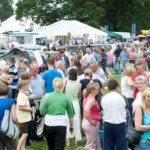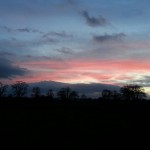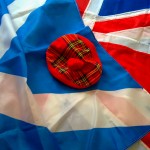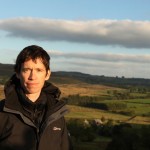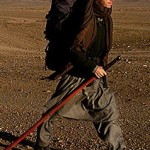First published in The Telegraph on 12th February 2014
From my starting point at Patterdale to the summit of Helvellyn the fog was with me, as it had been for two days. I could just make out three Herdwick sheep on the ridgeline track ahead – one chocolate brown, one dark grey and one silver. They were each a year apart in age, I guessed. It was, I had read, a special track. It had been a place for Dark Ages hunts and Viking settlers (whose place-names surrounded me), and a route for bandits raiding the Borders. But it was very difficult to feel the history. Even when the fog cleared, I saw only a landscape of open moorland and deserted fields. I am the member of parliament for this area, and I had hoped to learn from constituents during my walk, but the first people I saw, two hours further north, asked me for directions. They were a family called Dodd from Manchester aiming to climb Great Dodd for Mr Dodd’s 50th birthday.
At Threlkeld a thin man with enormous whiskers on his bony cheeks stepped out of his cottage door. Hearing that I was heading up on to the summit of Blencathra, Barry Todhunter suggested he feed me first. He led me into a small sitting room, on the wall of which stood a framed fox-tail. He and his wife shared their chicken pie with me. His wife grew up on the farm that stood 100 yards away. They first met and fell in love, it seemed, at her farm gate. There was no sign of any children in the house, but there was a terrier puppy in the living room, and in an annex there were 50 dogs. They were foxhounds, with elongated legs – great speckled animals that came up almost to my waist. The pack had lived on the site, it seemed, for a very long time, and become more distinctive with each generation.
‘They are descended from Briton and his companion, a bitch called Cruel. They were owned by John Peel,’ Barry told me. Todhunter is an ancient surname meaning fox-hunter, and through some improbable genetic legacy Barry is now a fox-hunter. He has been the huntsman of the Blencathra pack for almost 30 years. This is about average for the Blencathra – there have been five in the last 150 years – but he looked to me as though he was good for another 20. I was not in horse country. The hunt that followed them did so on foot. At night it stopped in pubs to sing fell songs. Not so much the famous song about the owner of Briton and Cruel, who was born in 1776 (‘D’ye ken John Peel with his coat so gray/D’ye ken John Peel at the break of day’), but many about Jim Dalton, who became the huntsman in 1886. The songs recorded the detail of his routes over about 300 square miles of country, taking in the tops of Helvellyn, Skiddaw and Blencathra. You could have sung them in place of a map.
Along Barrowside and through Ashness Ghyll,
Our huntsman he halloed both loud and shrill,
And straight to Armboth his course he did take.
In a landscape that felt so deeply rooted in history, I half expected to come across some of the myths about giants and fairies that Wordsworth and Sir Walter Scott had found – but I was struggling. Will, for example, lives across the valley from Barry. His family have farmed near the neolithic circle at Castlerigg for at least 400 years, perhaps even since the Vikings.
‘Do you have any legends about this area?’ I asked Will.
‘Like oral history? No. But my great-aunt did. I wish I had asked her before she died.’
‘What were her stories about?’
‘Well, the best one was about someone who shot a leopard in India.’
Barry had no myths about the hills either. Instead his legends focused on his predecessor as huntsman, Johnny Richardson, who escaped from a German prisoner-of-war camp and continued to hunt the hounds for 40 years until, running uphill on a cold day, he died from overexertion. Barry took me to a large shed that he had filled with a model railway. Dave, who lives two valleys away, had used his to recreate a postcard English landscape set about with elegant Victorian stations, but Barry had built a broad-gauge American railway that ran between giant water towers through an open prairie. When he is not hunting, Barry rides the American railways. He had just returned from a trip from Chicago to California.
By the time I left Barry, the sun was setting. I climbed the gentler south side of Blencathra. Blencathra was a word in the ancient Cumbric language, which everyone in this valley would once have spoken. The language was completely different from Scottish Gaelic or English. Its nearest relative was Welsh. Blencathra meant saddleback hill. The best surviving fragment of Cumbric is a lullaby. The words seem to emphasise how utterly different our ancestors were, in language and identity.
Peis Dinogat, e vreith, vreith,
o grwyn | balaot ban | wreith.
Chwit, chwit, chwidogeith,
gochanwn | gochenyn | wythgeith.
Dinogad’s smock, speckly, speckly,
Sewed from the fur of martens.
Whistle, whistle, whistly
we sing, the eight slaves sing.
In the rain and the dark, the rocks were slippier and sharper than I remembered. Climbing up the last 100 yards, I saw the silhouette of a sheep, its quizzical face looking down from the very summit. I slept on the top. At about 3am it seemed for a moment that the fog was clearing, and I could make out the red lights on the submarine aerials on the English coast. But at dawn there was nothing to be seen. I lit my stove to make some tea and porridge. The water was boiling before I realised I had somehow left both my mug and my spoon at Barry’s when repacking my bag. I ate the porridge with my fingers. There was nothing to be done about the tea.
I abandoned the fog at Blencathra and walked past Skiddaw, straight to the West Cumbrian coast at Maryport, turning there to Bowness-on-Solway. That section of the walk took six days. In the hills, the bracken and heather were cut with smooth emerald-green swards of sheep pasture. By Bassenthwaite I chatted to Sir Chris Bonington. Having made the first ascent of the South Face of Annapurna, in the Himalayas, he now lives looking at the back of Skiddaw. At Mirehouse I stayed with a man whose ancestor had captured a king of Afghanistan. His was a family that believed in getting things in writing. On the wall was a signed receipt that read, ‘Received one Afghan king, 1881’.
Then the ground flattened suddenly at Cockermouth into the Cumberland Plain. The walls went from limestone to sandstone, and from sandstone to hedges. At St Mungo’s church in Dearham I saw a stone depicting the Yggrassil, the tree central to the Viking pagan world, diplomatically supporting a Christian cross. Here I had passed an invisible border – the coal seam. Now that the pits have closed, life expectancy in Dearham is said to be almost 20 years lower than in neighbouring Bridekirk. At Silloth the harbour-master, who had moved from Dubai, introduced me to a Russian captain who had just sailed in from Kaliningrad and seemed a little confused that this sparsely populated part of north-west England lacked a ‘sailor’s club’. We directed him towards the pub.
At Bowness Mark Messenger walked me into the sea. We met at the old Roman fort, the very end of Hadrian’s Wall – which marked both a border of the Roman Empire and the border between England and Scotland. He had a broad pink face and was dressed in a green plastic smock, with a sack over his shoulder. Mark looked about 50. In his hand he carried a pole, to which was fixed a rigid net about the size of a small dining table. He smiled a lot. This reminded me that he had lost his teeth in a fight in Benidorm.
Mark was going fishing in the Solway. But first he had offered to guide me across a mile of water – from this point, on the English coast, to the Scottish coast. He explained that some fluke combination of the rippling outflow of the Esk and Eden rivers on our right and the tides of the Atlantic Ocean had left a patch of ground shallow enough to cross. This had not been possible at this point for 20 years, but it had been possible in the past. Somewhere near our feet was the bell of Bowness church, which Scottish raiders had dropped in the sand in 1626 and lost. The bells in Bowness were stolen back across the water in revenge from the churches on the Scottish coast.
Four other men, dressed like Mark in waterproof smocks, stood in the sea to the east. They had mostly worked in factories in Carlisle, but it seemed one had been on the railways. Walter Scott described men in the 18th century fishing in the Solway, spearing salmon on horseback – a difficult task from high above the water, with the refraction of the light. But then, as now, the greatest problem was the tides. A rip tide, with the wind behind it, moves faster than a person can run. It can drown them. The tide began behind me as a slow movement of brown water on grey sand, a break in the ripples of the river water, and then, as we pushed on, the sands began to vanish. But there was no wind, and Mark seemed calm.
He and his friends fished on foot. They caught the salmon on the ebb and flow in their large, rigid, hand nets. A barrage of angry river-owners and environmental agencies had tried to stop them from fishing. Licences were limited: they could now only fish in daylight hours, in the set season. Each fish needed to be tail-tagged and recorded in a book, and a plastic strip for each fish sent to an agency in Bristol. But they had no intention of stopping. Only 50 people now fish in this way. It is called haaf-netting – a Viking word – and Mark and his friends believe that people have been doing it in the Solway since the Viking era. As I passed one of them he shouted, ‘No one Mark has ever guided has made it back alive.’
Mark bared his gums, and we pressed on. The secret, he explained, is never to leave your feet still in the sand. If you do, the sand will disappear beneath your feet and you will be unable to pull your boots out. The other secret is to prod with your stick to make sure there isn’t a hidden shelf. The water was beginning to reach our chests and I wasn’t confident I would be able to swim in the waders. And then, just as suddenly as it had risen, the water began to recede, and Mark, knowing I was safe, turned back into the waves, holding his net high on his shoulders. He wasn’t sure whether he would be in time to catch the salmon on the flow. I climbed up on to a long shore littered with blocks of black granite, concrete and wooden pilings. There was a scum of bird feathers at the high-tide mark. Birds circled, paddled and floated on every side. As I worked my way inland I came across safer fords, which had once been highways for armies. Edward I died at Burgh by Sands.
He demanded that his bones should be boiled down and carried at the head of the troops in all future battles against the Scots. Here too thousands of men and horses of a Scottish army had drowned in an unexpected flood, trying to skirt Carlisle. I moved slowly towards a flat horizon over smoke-smudged sands. Reeds surrounded me. The border between England and Scotland at this point is the Sark, a trickle of a stream, which I could almost leap. A large sign on a white building said on one side, ‘Last house in Scotland’, and on the other, ‘First house in Scotland’. But what feature of the rock or soil made it Scotland? None that I could see. Instead, the differences came from the arbitrary end of a local council. The north end had a mown lawn and no litter; the south was unmown, with plastic bottles scattered around.
I crossed the M6 and then a railway bridge. A Virgin train passed beneath me at close to 125 miles per hour, hammering towards Glasgow. I was not anticipating this sudden frontier of sound, a pedestrian in the slipstream of heavy racing metal. And then, just a little further on, there was a high-voltage power line carrying Scottish power to England. And then I was through these lines and back into some of the loneliest, most sparsely populated terrain in Britain.
I was skirting the edge of the debatable land. This territory, which once belonged to neither England nor Scotland, lies in a flat depression between the Esk and the beginning of the Scottish hills. Until 1600 both governments decreed that anyone found living in it would be killed on sight. But it was settled repeatedly by border cowboys, horse-borne clans who kept cattle and paid blackmail (a word they invented) to protect their flocks. I climbed the narrow stone stairs of one of Johnnie Armstrong’s towers, standing by the Esk. It was four storeys high and one room wide, and the walls, six feet thick, were made of huge cold blocks. It was designed as a temporary safe house, a place to take refuge while Johnnie’s enemies, having stolen his cattle, tried to burn him out, and his friends – hopefully – rode to the rescue. Johnnie had no decent farmland to speak of, but was somehow able to support almost 160 men in his 16th-century band.
On a single raid they could steal thousands of cows. When the king of Scotland came south Johnnie rode to meet him in 1530, hoping to impress him, with his chosen men, all wearing cloth of gold. This was a mistake: the king hanged them all on the spot.
Duncan Telford lives in the Bailey valley, two days on from my Solway crossing. In his yard is a ruined bastle house – a smaller, one-storey version of a pele tower. The photocopies of copper-plate parish records on his dining table showed Telfords moving between farms in this valley, on the English side of the border, for 300 years. Before that, however, it seemed they came from Scotland. In particular from Dodhead, a homestead set in a bleak stretch of remote moorland, known, improbably, as ‘the Fair Dodhead’. Outside the kitchen window is a circle of standing stones. These look neolithic, but they were built by Duncan as a place where he and his friend Cack could drink, chat, and smoke whatever Duncan rolled. Beyond the stones stretched acres of rough, reed-infested, wet ground, on which stood a few sheep. The ground was very poor, and Duncan had apparently made no attempts to burn back the reeds, plant new grasses or drain it.
Duncan had persuaded a trekking company at Bailey Mill to lend us two horses. His was a full two hands higher than mine. We rode up behind Tarras Moss so he could show me where the clans had once taken refuge. The upper slopes were split with sudden peat hags; again and again we had to turn the horses round to try to find a path through streams, through bog, through gullies, and through sphagnum moss. Rather than splash through the streams, my horse preferred to jump dramatically – clearing each stream by at least four feet. Duncan’s ancestors, who specialised in navigating this moss, had been known as moss-troopers, or reivers.
Duncan named his son Reeve. He has a reiving tattoo. He likes the fact that they still use the old nicknames, calling people after their farms, or after other things.
‘Look at the names,’ he said. ‘Colin of Cumrook, Buggerback or Nebless Clem.’
What was your nickname? I asked.
Duncan pushed his hair back from his earring, took his hands from the reins, and rolled another cigarette. ‘What do you think?’ he said, grinning broadly. I had no idea.
From the Bailey I walked on to Hermitage Castle – a vast abandoned fortress in an otherwise almost entirely empty valley. In Newcastleton I found Duncan in the pub. This was surprising. He had told me he was banned from all the pubs in Newcastleton. He was there with his wife, son and daughter, his cousin Trevor, and his neighbour Steve. Big Colin Charnock, who was often with them, was absent: ‘South, buying cattle.’ In the corner, wearing cords and a V-neck jumper, sat Philip Howard. Philip’s family have lived for 41 consecutive generations in Naworth, a nearby castle. He was talking cheerfully to Duncan about ‘the hanging tree’, on which his ancestor had hanged several Armstrongs.
‘Sixty-three in two years,’ he said proudly. ‘We’ve another tree on which my father always promised me we hung 46 members of the Hay family – which was another good day. We had seven separate dungeons, but sadly that wing got burnt down. We’ve only got one left.’
We were interrupted by a miniature bagpipe. The player had a gaunt face, a goatee and a long white pony-tail. The bagpipes were the Border version – pushed with a bellows, rather than blown. First he played a ballad about the hanging of Johnnie Armstrong. Duncan seemed divided on this particular episode.
‘The only way to sort them out was to hang ’em, and hang all his men and all, simple as that I would think,’ he said.
‘But who was the bigger villain?’ the piper asked.
‘The king… The government,’ Duncan concluded.
Newcastleton is on the Scottish side of the border, Duncan lives on the English side. But Duncan insisted they were all one reiving culture. I wasn’t so sure. On a table beside us was a middle-aged couple from Melrose, and beyond them two water engineers from Edinburgh. They kept staring at Cack, who had come out from his caravan in full combat fatigues.
He looked very pale and was not singing. Duncan’s son had brought along some drumsticks. Duncan sat Reeve on his lap, and, while singing, they began to play a drum roll together, surprisingly well. No one else in the pub joined in.
Now the singer sang about Duncan’s ancestor Jamie Telford of Fair Dodhead. This was bold, since there are four different versions of the song, each one blaming a different family for betraying him. In this version the villains were the Eliots, whose chief still lives four miles out of town. Jamie was raided. The call to arms to rescue his flock covered every valley for 100 square miles: names of farms that were now nothing but a faint trace of stone in the reeds and farms that are still farms today.
Warn Gaudilands, and Allanhaugh,
And Gilmanscleugh, and Commonside.
Ride by the gate at Priesthaughswire,
And warn the Currors o’ the Lee.
And yet it was not quite untrue to say this was a scene unchanged from the days of the border reivers. Duncan was wearing a baseball cap and a T-shirt that said, ‘Redneck warrior.’ He was looking relaxed, so I asked him again what his nickname was:
‘Dunk the Punk,’ he replied.





